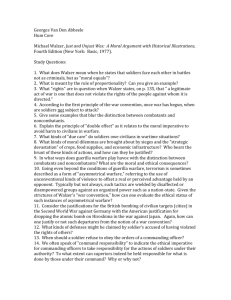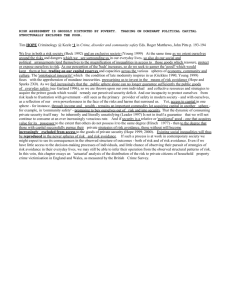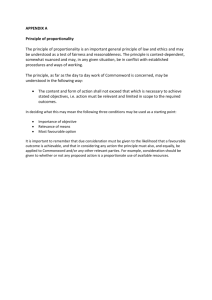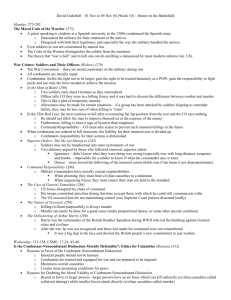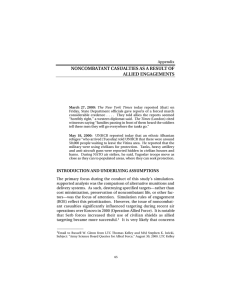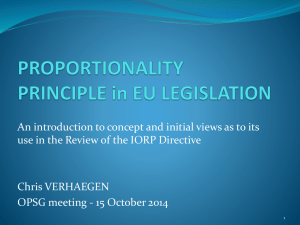Force Protection and Noncombatant Immunity
advertisement
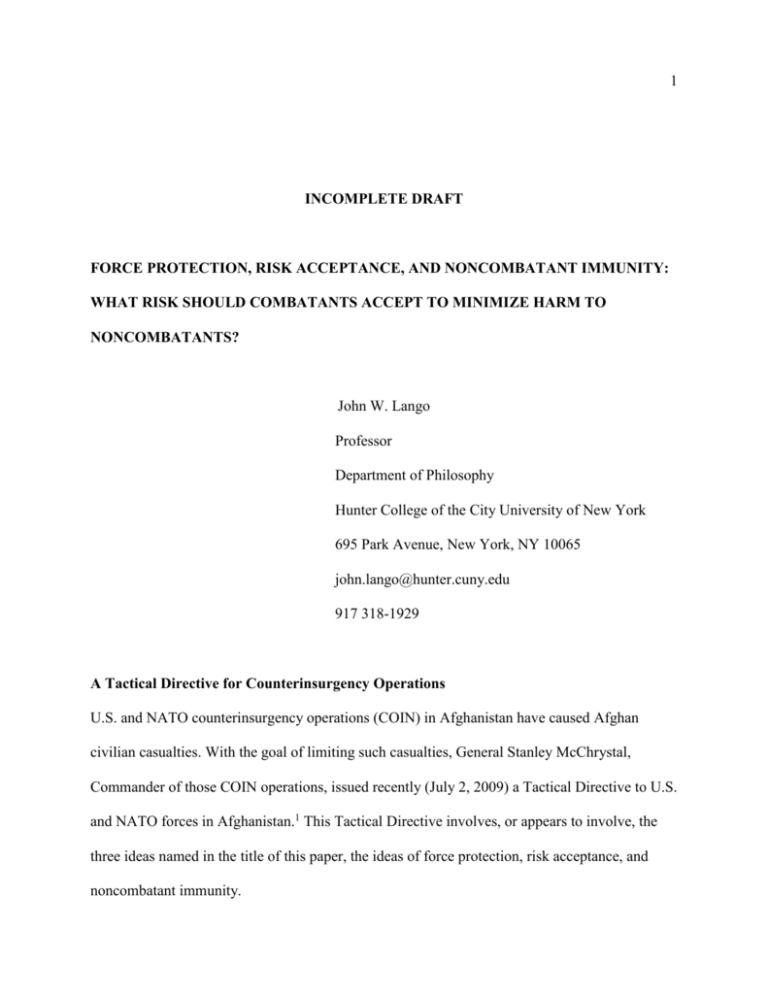
1 INCOMPLETE DRAFT FORCE PROTECTION, RISK ACCEPTANCE, AND NONCOMBATANT IMMUNITY: WHAT RISK SHOULD COMBATANTS ACCEPT TO MINIMIZE HARM TO NONCOMBATANTS? John W. Lango Professor Department of Philosophy Hunter College of the City University of New York 695 Park Avenue, New York, NY 10065 john.lango@hunter.cuny.edu 917 318-1929 A Tactical Directive for Counterinsurgency Operations U.S. and NATO counterinsurgency operations (COIN) in Afghanistan have caused Afghan civilian casualties. With the goal of limiting such casualties, General Stanley McChrystal, Commander of those COIN operations, issued recently (July 2, 2009) a Tactical Directive to U.S. and NATO forces in Afghanistan.1 This Tactical Directive involves, or appears to involve, the three ideas named in the title of this paper, the ideas of force protection, risk acceptance, and noncombatant immunity. 2 A concept of force protection is stated emphatically in the Tactical Directive: (NOTE) This directive does not prevent commanders from protecting the lives of their men and women as a matter of self-defense where it is determined no other options (specific options deleted due to operational security) are available to effectively counter the threat. Traditionally, the just war principle of noncombatant immunity prohibits combatants from harming noncombatants intentionally. Frequently, however, this principle is also construed as permitting combatants to cause foreseen but unintended harm to noncombatants, but only if that harm is not disproportionate. Such a concept of noncombatant immunity is implied, or appears to be implied, in the Tactical Directive:2 I expect leaders at all levels to scrutinize and limit the use of force like close air support (CAS) against residential compounds and other locations likely to produce civilian casualties in accordance with this guidance. Commanders must weigh the gain of using CAS against the cost of civilian casualties, which in the long run make mission success more difficult and turn the Afghan people against us. In Just and Unjust Wars, Michael Walzer revised the traditional noncombatant immunity principle. In particular, he inserted a qualification about risk acceptance: “If saving civilian lives means risking soldier’s lives, the risk must be accepted.”3 Such a qualification also occurs in the new U.S. counterinsurgency field manual (COIN FM): "Combat, including counterinsurgency 3 and other forms of unconventional warfare, often obligates Soldiers and Marines to accept some risk to minimize harm to noncombatants."4 And a comparable qualification is expressed, or appears to be expressed, by General McChrystal in the Tactical Directive: “I recognize that the carefully controlled and disciplined employment of force entails risks to our troops -- and we must work to mitigate that risk wherever possible.” A crucial reason for limiting the use of force in Afghanistan in order to minimize civilian casualties is stated in the the Tactical Directive as follows. “We must avoid the trap of winning tactical victories -- but suffering strategic defeats -- by causing civilian casualties or excessive damage and thus alienating the people.” Indeed, in the words of the Tactical Directive, this is “an overarching operational issue,” but also it is “a legal and a moral issue.” While acknowledging the operational and legal facets of the issue, I am concerned in this paper with the moral facet. The Question of Risk Acceptance In particular, I want to investigate the moral question stated in the subtitle. What risk should combatants accept to minimize harm to noncombatants? I shall term this the question of risk acceptance. To begin with, I need to sharpen this moral question. Although jus in bello principles can be used retrospectively to make moral judgments about past military operations, it is most important that they be used prospectively to make moral judgments about future military operations, or military operations that are presently occurring. For their fundamental purpose should be to morally constrain agents from engaging in unjust military actions. Accordingly, the risk-acceptance question can be reformulated more specifically as follows. When agents plan a future military operation or reexamine an ongoing military operation, what risk should they require their combatants to accept in order to minimize harm to 4 noncombatants? The noncombatant immunity principle is controversial. For the sake of brevity, I have to set aside much of this controversy. How are noncombatants distinguished from combatants? What is the difference between intentionally harming noncombatants and knowingly but not intentionally harming them? When agents plan a future military operation or reexamine an ongoing military operation, are they warranted in expecting that their combatants will not intentionally harm noncombatants? I shall term the preceding question the question of intentionality. How is the harm of foreseen but unintended noncombatant casualties to be weighed against the good of achieving a military objective? When agents plan a future military operation or reexamine an ongoing military operation, are they warranted in expecting that the good of achieving their military objective will outweigh the harm of foreseen but unintended noncombatant casualties? I shall term this last question the question of proportionality. I have to set aside these and other questions about the principle. In what follows, it is assumed that they can be answered adequately. For the sake of clarity, I shall consider only those military operations concerning which the questions of intentionality and proportionality can be answered affirmatively. I shall term them proportionate military operations. My purpose is to disentangle controversies about the doctrine of double effect (DDE) and controversies about the concept of proportionality from controversies about the idea of risk acceptance. Accordingly, the risk-acceptance question can be reformulated even more specifically as follows. When agents plan a future proportionate military operation or reexamine an ongoing proportionate military operation, what risk should they require their combatants to accept in order to minimize harm to noncombatants? More briefly, to coin a phrase, the question is this. Within the compass of intentionality and 5 proportionality, what risk should be accepted?5 Frequently, when agents plan a military operation, they envisage alternative courses of action for achieving the military objective. In the Tactical Directive, General McChrystal mentions military operations with close air support, but there also are ground operations without air strikes. Once again, in order to disentangle controversies about double effect and proportionality from controversies about risk acceptance, I shall consider only those courses of military action concerning which the questions of intentionality and proportionality can be answered affirmatively. I shall term them proportionate courses of military action. Accordingly, I shall not consider, for example, military operations of the following two sorts: The most efficient course of military action would be disproportionate, but the acceptance of sufficient risk would make it proportionate. The most efficient course of military action would be proportionate, but the acceptance of too much risk would make it disproportionate. A key point is that, within the compass of intentionality and proportionality, there can be alternative proportionate courses of military action, some of which result in more noncombatant casualties than others. For an illustration, let me sketch hypothetically some planning for a proportionate U.S. military operation in Afghanistan. A credible intelligence report confirms that a high-level al-Qaeda leader is hiding in a safe house nestled in the center of a village. In planning a military operation to kill him, two courses of military action are envisaged, an air strike and a ground operation. It is expected that, if he were killed by an air strike, quite a number of noncombatants would be killed. Nevertheless, the proportionality question is answered affirmatively. Alternatively, it is expected that, if he were killed by a ground operation, far fewer noncombatants would be killed, but also there would be a significant risk that a few U.S. combatants would be killed. Nonetheless, this al-Qaeda leader is so high-level that the 6 proportionality question is again answered affirmatively, despite the risk of U.S. combatant casualties. Evidently, a particular risk-acceptance question can be raised about this hypothetical military operation. In order to minimize harm to noncombatants, should U.S. combatants be expected to accept this risk of death? How, then, should the question of risk acceptance be answered? “It is best,” Walzer maintained, “to say simply that civilians have a right that ‘due care’ be taken.”6 But how should agents take due care? In Double-Effect Reasoning, T. A. Cavanaugh asserted: “Due care is a prudential matter about which reasonable people reasonably disagree.”7 To the contrary, I shall argue in this paper that due care is a moral matter, that the question of risk acceptance can be answered by means of a deontological principle of distributive justice. * * * * * This paper is incomplete (as of September 29, 2009). Relevant literature appears to be sparse. Concerning the question of risk acceptance, Cavanaugh remarked: “Most advocates of double effect have not addressed this question.”8 The question is discussed briefly by Tony Coady,9 Anthony Hartle,10 and Brian Orend.11 It is discussed at greater length by James M. Dubik12 and Tony Pfaff.13 In the completed paper, I intend to discuss these and other writings, especially Walzer’s Just and Unjust Wars. 7 Notes 1. Portions of this directive have been publicly released, and are available at http://www.nato.int/isaf/docu/official_texts/Tactical_Directive_090706.pdf. 2. Instead of the term “noncombatant,” the Tactical Directive uses the term “civilian.” Disputably, the concept of civilians is different from the concept of noncombatants, but I cannot engage in that dispute here. The line of reasoning in this paper would not be affected if the word “civilian” were substituted throughout for the word “noncombatant.” 3. Michael Walzer, Just and Unjust Wars, 4th ed. (New York: Basic Books, 2006), p. 156. 4. The U.S. Army/Marine Corps Counterinsurgency Field Manual (Chicago: University of Chicago Press, 2007), ch. 7, par. 21. 5. See Walzer, p. 156n. In this note, Walzer interrelates proportionality and risk acceptance. 6. Walzer, p. 156. 7. T. A. Cavanaugh, Double-Effect Reasoning: Doing Good and Avoiding Evil (Oxford: Oxford University Press, 2006), p. 35. 8. Cavanaugh, p. 34. 9. C. A. J. Coady,, Morality and Political Violence (Cambridge and New York: Cambridge University Press, 208), pp. 142-5. 10. Anthony Hartle, “Discrimination”, in Moral Constraints on War: Principles and Cases , ed. Coppieters, Bruno, and Nick Fotion, (Lanham, Md.: Lexington Books, 2002), pp. 146-47. 11. Brian Orend, Michael Walzer on War and Justice (Montreal: McGill-Queens University Press, 2000), pp. 119-20. 12. James M. Dubik,“Human Rights, Command Responsibility, and Walzer's Just War Theory,” 8 Philosophy and Public Affairs 11:4 (Autumn, 1982), pp. 354-371. 13. Paff, Major Tony Pfaff, “Non-combatant Immunity and the War on Terrorism,” JSCOPE 2003. Available at http://www.usafa.edu/isme/JSCOPE03/Pfaff03.html.
